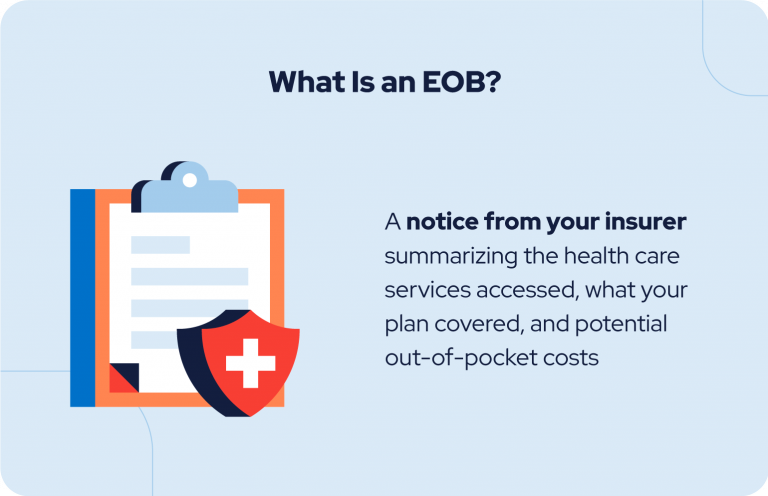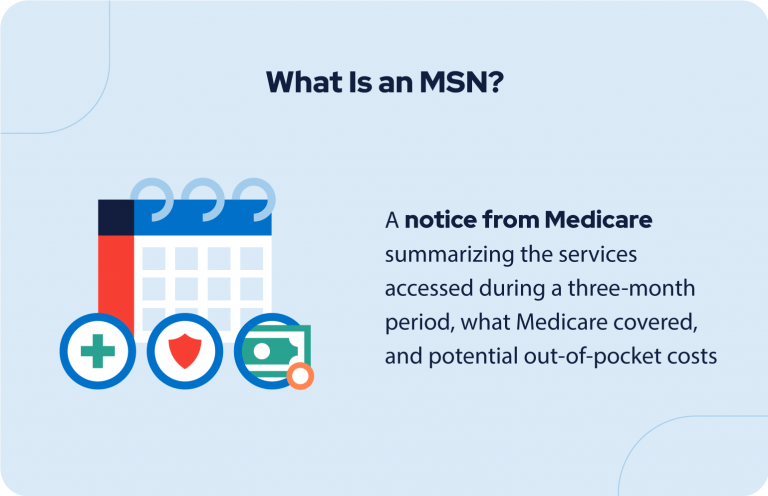How to Read Your Medicare EOBs and MSNs
Medicare Explanations of Benefits (EOB) and Medicare Summary Notices (MSN) are statements summarizing the services you accessed under Medicare, the costs covered and how much you may be billed. This guide covers how to read your Medicare EOBs and MSNs with example medical statements.

- Edited By
Matt Mauney

Matt Mauney
Financial Editor
Matt Mauney is an award-winning journalist, editor, writer and content strategist with more than 15 years of professional experience working for nationally recognized newspapers and digital brands. He has contributed content for ChicagoTribune.com, LATimes.com, The Hill and the American Cancer Society, and he was part of the Orlando Sentinel digital staff that was named a Pulitzer Prize finalist in 2017.
Read More- Published: April 28, 2021
- Updated: December 19, 2024
- 7 min read time
- This page features 7 Cited Research Articles
Understanding your health insurance plan goes beyond keeping track of your monthly premiums. There are other associated costs that you have to be aware of.
Statements like Explanations of Benefits (EOB) and Medicare Summary Notices (MSN) help you better understand these costs. Though they may look like bills, they’re not.
These notices inform you of the costs covered by your plan provider and how much you might have to pay out-of-pocket.
This guide explains how to read Medicare EOBs and MSNs by explaining the different sections in the statements.
What Is an Explanation of Benefits?

An explanation of benefits (EOB) is a notice from your Medicare provider that you receive monthly or after accessing health care services. It includes a description of your plan, the costs of services, how much your insurer covered and out-of-pocket costs you may have to pay.
If you enroll in Medicare Advantage plans, you’ll either receive an EOB monthly or on a per-claim basis, along with quarterly summary statements.
However, there are circumstances under which your plan provider is not required to send EOBs.
- There’s no claim activity during a reporting period.
- You’re eligible for both Medicare and Medicaid.
Enrollees who have a Medicare Part D plan will get an EOB at the end of every month detailing the covered prescriptions you filled during the previous month. The EOB also includes information on the current payment stage for your plan, which determines how much you’ll pay for drugs covered by the plan.
Whenever you receive an EOB from your plan provider, you should check it for mistakes or signs of fraud. Keep your medical receipts and compare them against the claims listed on your EOB. You can also check the progress toward satisfying the required deductibles for your plan.
How to Read an EOB
EOBs may look different depending on your provider, but they generally include similar information. An EOB summarizes the items and services you accessed, the amount charged to Medicare, how much was covered by Medicare and how much you owe.
Below is a sample EOB with different sections labeled and explained.
After reviewing your EOB, if you have any questions or complaints, call your health insurance provider.
How Long to Keep an EOB
An article from the New York Times recommended keeping your EOB on file for at least one year to track payments, detect discrepancies and verify that bills have been paid in full.
If you plan to file for medical expense deductions, it’s recommended that you keep your EOB along with other tax documentation for six to seven years.
If you’re not filing for medical tax deductions, you’ve fully paid your bills, and you’re no longer seeking the services on your EOB, the National Association of Productivity & Organizing (NAPO) recommends shredding last year’s collection of EOBs.
For those with a serious medical condition that has improved, NAPO recommends keeping your EOBs for five years if you don’t qualify for medical expense deductions.
Checking Your Medicare EOB Online
Your plan provider may offer the option to check your EOB online instead of getting them via mail. Your plan provider should have instructions on its website for accessing your EOBs online.
Typically, you would have to log into your account on your insurance provider’s website, and your EOB would be found in the claims-related section.
To check the status of your current Medicare claims online, log into your Medicare account and download the claims information.
What Is a Medicare Summary Notice?

A Medicare Summary Notice (MSN) is a statement you receive every three months from Medicare that details the health care services you accessed during that period. It includes how much Medicare paid and how much you may have to pay the provider.
If you didn’t access any services or receive medical supplies during a given three-month period, you won’t get an MSN for that period.
As with your EOBs, you should compare your MSNs against receipts and bills to ensure you got all the services listed. Keep an eye out for mistakes and any claims that may have been denied.
How to Read a Medicare Summary Notice
The MSNs for Part A and Part B are issued by Medicare, and their formats are identical.
- A summary page that provides an overview of your claims and deductible status
- A tips page that provides guidance on how to review your notice, how to get help with Medicare and how benefit periods work
- A claims page that details each claim, whether they were approved and the potential out-of-pocket costs
- A how-to page that provides instructions on handling denied claims
The MSN for Part A shows all the services billed to Medicare for hospital, hospice care and home health care services. The MSN for Part B shows the services billed by Medicare for doctor services, outpatient care, preventative services or other medical services.
Below is a sample MSN with different sections labeled and explained.
Medicare Summary Notice Appeal Process
Your doctors or insurance providers will usually file Medicare claims for you, but you should always check whether the claims were approved or denied on your MSN. You may file an appeal if Medicare ever denies your request for a health care service or product you think should be covered or a request for payment for a service or product that you already received.
Before filing an appeal, you can also call Medicare customer service to inquire about your denied claims or appoint a representative to file an appeal on your behalf.
To file an appeal for Original Medicare, you must fill out the appeals form on your MSN and mail it to the Medicare Claims Office before the specified deadline.
The appeals process has five levels. If you disagree with the decision made at any level of the process, you can usually appeal to the next level.
Accessing Your Medicare Summary Notice Online
You can choose to receive electronic MSNs instead of print copies to access your Medicare information at any time.
- Create or log into your Medicare account.
- At the top of the homepage, click “Get your Medicare Summary Notices (MSNs) electronically” under the section for messages.
- Once you arrive at the communication preferences page, click “Yes” where it says “Change eMSN preference.”
If you choose to receive eMSNs, you’ll get a monthly email when MSNs are available, and you won’t have to wait three months for a paper copy.
With eMSNs, you’ll be able to track your monthly claims and check your remaining deductible amounts more easily.
How Long to Keep Your Medicare Summary Notice
Similar to EOBs, it’s standard to keep your MSNs for at least one full calendar year to confirm that all bills have been paid. Tax preparers also recommend keeping your MSNs for six to seven years if you claim your medical expenses as a tax deduction.
When it’s time to dispose of the hard copies of your MSN, shred them in order to protect yourself from identity theft.
EOBs and MSNs can help you keep track of the costs of health care services you’ve received, the amount covered by your Medicare plan and how much you have to pay out-of-pocket. Keep these notices for at least a full year to ensure that the records are correct and the bills have been paid in full.
7 Cited Research Articles
- U.S. Centers for Medicare & Medicaid Services. (2021, August). Part A - What is in your “Medicare Summary Notice”? Retrieved from https://www.medicare.gov/sites/default/files/2021-08/summarynoticea.pdf
- Centers for Medicare & Medicaid Services. (2021, August). Part B: What’s in Your Medicare Summary Notice? Retrieved from https://www.medicare.gov/sites/default/files/2021-08/summarynoticeb.pdf
- U.S. Centers for Medicare & Medicaid Services. (2018, July). Reading your Explanation of Benefits. Retrieved from https://www.cms.gov/files/document/11819-sample-explanation-benefits-508.pdf
- Capital Gazette (2012, September 30). Covering the Bases: Keep Medicare Summary Notices for at least a year. Retrieved from https://www.capitalgazette.com/cg2-arc-66a2ef1c-af1e-5afd-8a05-bf05ff31c6bb-20120930-story.html
- American Association of Retired Persons. (2012, April 12). What You Can Learn From Your Explanation of Benefits Statement. Retrieved from https://www.aarp.org/health/medicare-insurance/info-10-2010/learn_from_EOB.html
- Medicare.gov. (n.d.). Go digital. Retrieved from https://www.medicare.gov/go-digital
- U.S. Centers for Medicare & Medicaid Services. (n.d.). Helping people in Medicare Advantage & Medicare Prescription Drug Plans understand their “Explanation of Benefits” (EOB). Retrieved from https://www.cms.gov/Outreach-and-Education/Outreach/Partnerships/Downloads/11234-P.pdf
Calling this number connects you to one of our trusted partners.
If you're interested in help navigating your options, a representative will provide you with a free, no-obligation consultation.
Our partners are committed to excellent customer service. They can match you with a qualified professional for your unique objectives.
We/Our Partners do not offer every plan available in your area. Any information provided is limited to those plans offered in your area. Please contact Medicare.gov or 1-800-MEDICARE to get information on all of your options.
888-694-0290

